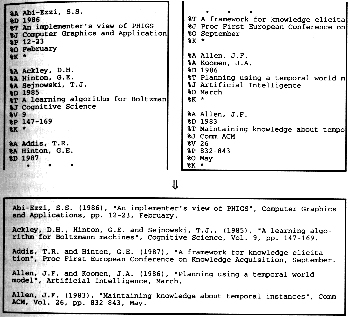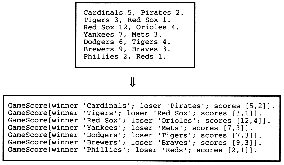

Three such tasks are illustrated in Figures 1-3. They all involve reformatting textual databases: an address list, a set of match scores, and a bibliography. Each can be accomplished using an editor with a macro definition capability, but this requires careful advance planning and is difficult to get right the first time. Moreover, any programming solution suffers from excessive rigidity--in reality, the tasks are defined incrementally and may be extended as more examples are encountered. In practice, people are likely to accomplish such tasks by manually editing each entry, perhaps using global search-and-replace to perform sub-tasks where feasible.
Programming by demonstration seems a natural way to approach these problems. Rather than programming a task, users need only demonstrate examples of how to perform it, from which a program is synthesized that performs the task itself. [Nix 84] has investigated the application of "by example" techniques to text editing by looking only at inputs and outputs, and seeking a transformation that maps blocks of input text into corresponding output blocks. While this works well for rigidly-structured tasks like that of Figure 2 (which was taken from Nix's thesis), it breaks down when faced with less artificial transformations that involve rules and exceptions, like those of Figures 1 and 3. In contrast, the scheme developed in the present paper adopts a procedural stance: editing actions are recorded and generalized into a program that transforms input into output. This seems to offer better potential for complex, ill-structured, editing problems where many different cases may arise.



Tasks within the domain: Reformatting textual data
Intended users: non-programmers
Types of examples: TELS learns from a single block of text which may
include several examples of some steps. Then, it incrementally generalizes or
modifies the constructed program as the user confirms or corrects subsequent
predictions. It generalizes character string patterns and procedures from
multiple examples.
If the user rejects a prediction, TELS treats the predicted text selection as a negative example: when searching, TELS skips over any selections that match a negative example.
Program constructs: Variables, loops, nested loops and conditionals.
back to ...  Table of Contents
Table of Contents  Watch What I Do
Watch What I Do